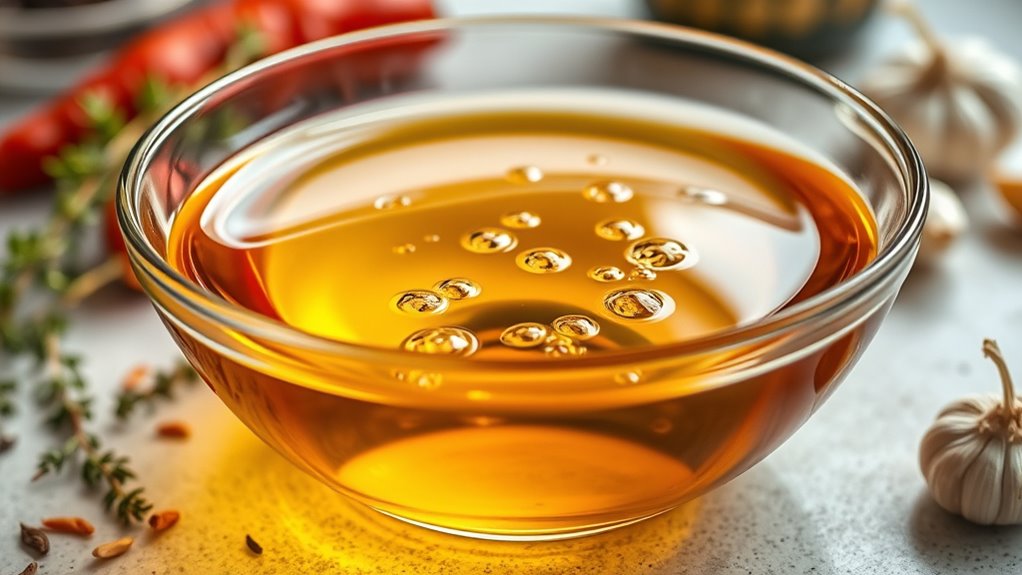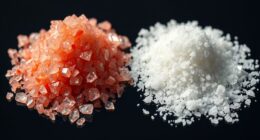Cooking oils are mainly made of triglycerides, which are molecules of fatty acids attached to glycerol. Their chemical makeup varies based on the types and chain length of these fatty acids—saturated, monounsaturated, or polyunsaturated—affecting texture, flavor, and stability. Minor components like antioxidants also influence shelf life and health benefits. Understanding these chemical structures and interactions reveals how oils behave during cooking. Exploring further uncovers the fascinating chemistry that impacts your kitchen experiences.
Key Takeaways
- Cooking oils are primarily composed of triglycerides formed from various fatty acids, affecting their physical and chemical properties.
- The level of unsaturation (number of double bonds) influences oil stability, melting point, and susceptibility to oxidation.
- Measurement tools like iodine number quantify unsaturation, predicting an oil’s stability and suitability for cooking or industrial use.
- Minor components such as antioxidants and phytosterols contribute to oil stability, flavor, and health benefits during cooking.
- Heat induces chemical changes in oils, including polymerization and oxidation, which impact flavor, texture, and nutritional quality.
Composition of Triglycerides in Cooking Oils
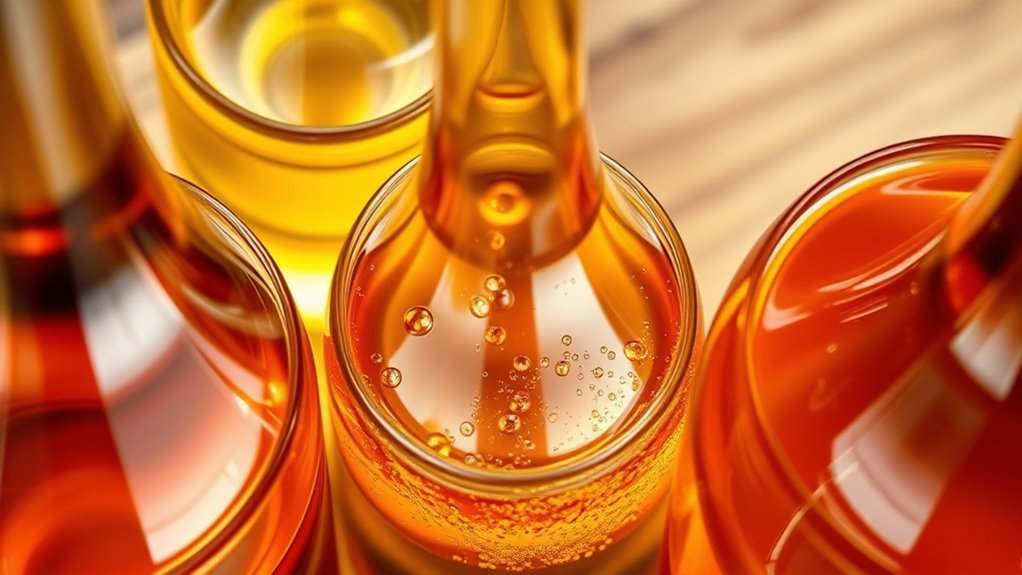
Have you ever wondered what makes up the triglycerides in cooking oils? Triglycerides consist of three fatty acids attached to a glycerol backbone, forming the basic structure. Most natural oils contain mixed triglycerides, meaning different fatty acids occupy various positions, often with specific placements like unsaturated acids at carbons 1 and 3 in animal fats. Unlike lab-made simple triglycerides with identical fatty acids, natural oils are diverse, influenced by species and processing methods. Chain length varies, with coconut oil rich in shorter lauric acid (C12), while olive oil mainly contains C18 fatty acids like oleic and linoleic. Unsaturation levels greatly impact oil properties, affecting melting points and stability. Fatty acid composition influences the flavor, texture, and stability of cooking oils, making each type unique for culinary uses. Additionally, the chemical structure determines how oils react to heat and oxidation, affecting shelf life and nutritional value. The molecular arrangement of triglycerides also plays a significant role in the physical characteristics of oils, such as viscosity and crystallization behavior. These variations contribute to the unique flavors, textures, and uses of different cooking oils.
Types and Structures of Fatty Acids
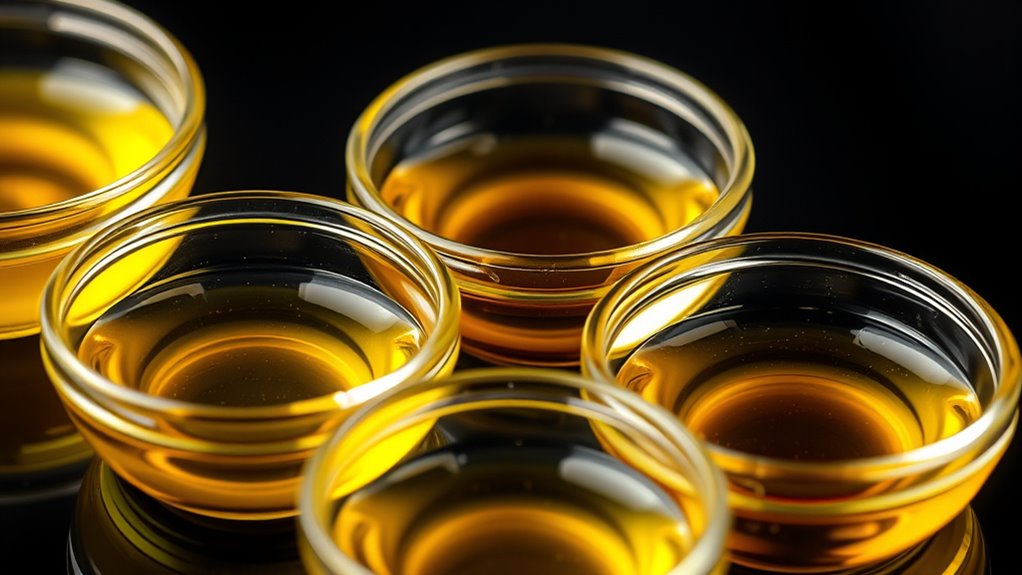
Understanding the types and structures of fatty acids is essential to grasp how oils behave and their health impacts. Fatty acids fall into categories like saturated, monounsaturated, and polyunsaturated. Saturated fatty acids, found in coconut and palm oils, are solid at room temperature and can raise cholesterol. Monounsaturated fatty acids, predominant in olive and avocado oils, are liquid and considered heart-healthy. Polyunsaturated fatty acids, including omega-3 and omega-6, are abundant in sunflower and flaxseed oils and are essential for your body. Their structures differ mainly by chain length and the number of double bonds. The presence of double bonds affects oil stability and health effects. Research supports that the specific composition of fatty acids influences their health benefits and cooking properties. Fatty acid structure also impacts how oils react to heat and oxidation during cooking. The degree of unsaturation can determine an oil’s smoke point, which is crucial for selecting appropriate cooking methods. Additionally, oxidation stability varies among different oils based on their fatty acid composition, influencing their shelf life and suitability for high-temperature cooking. Recognizing the environmental impact of sourcing different oils can help consumers make more sustainable choices. Understanding these differences helps you choose oils that suit your dietary and cooking needs.
Unsaturation and the Iodine Number
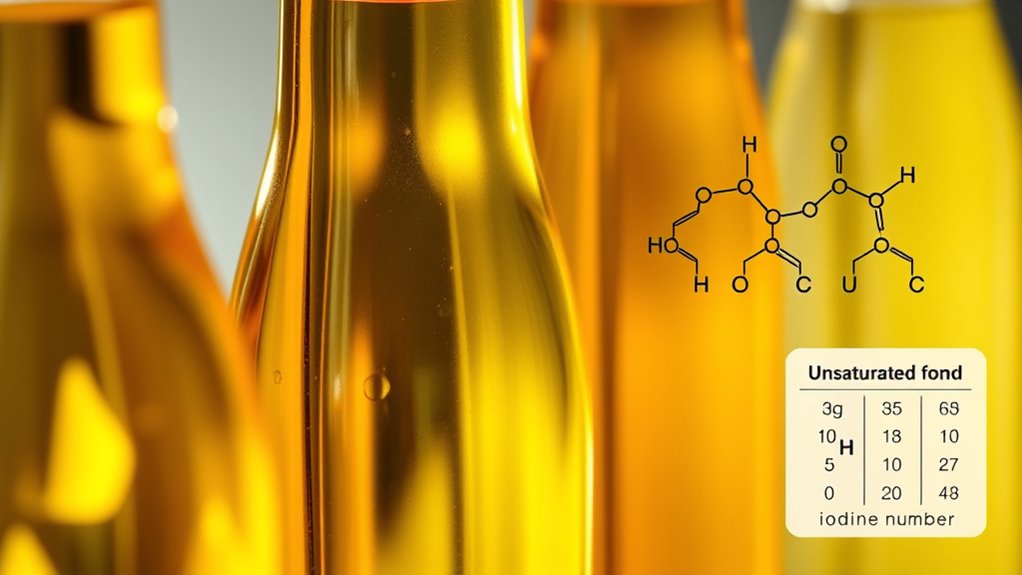
The degree of unsaturation in cooking oils is often quantified using the iodine number, a metric that measures how many grams of iodine are absorbed by 100 grams of fat or oil. This value directly correlates with the number of double bonds in the fatty acids; more double bonds mean higher iodine numbers and greater unsaturation. The iodine reacts with these double bonds through halogenation, and the amount absorbed is measured either via spectrophotometry or titration, following standards like AOCS or ISO. Oils like linseed have high iodine numbers, indicating high unsaturation, while coconut oil has low values. The iodine number helps predict an oil’s oxidation stability, shelf life, and suitability for various culinary and industrial applications. Vibe coding can be used to analyze and predict these properties based on the molecular structure of the fats. Additionally, the chemical composition of the fats influences their behavior during cooking and storage. Understanding the degree of unsaturation is essential for selecting the appropriate oil for different culinary needs and ensuring optimal storage conditions. Moreover, oxidation stability is a critical factor that affects an oil’s shelf life and cooking performance, especially for highly unsaturated oils. Advances in analytical techniques have improved our ability to accurately measure and predict these properties, aiding in better oil selection.
Physical Properties Influenced by Chemical Composition
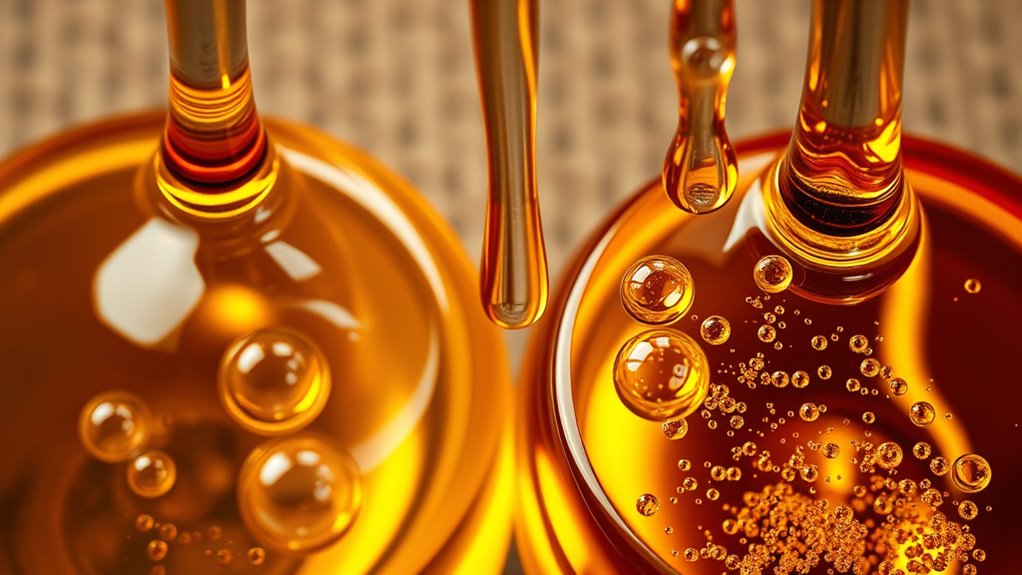
Chemical composition substantially influences the physical properties of cooking oils. The length of hydrocarbon chains determines viscosity; longer chains (C16-18) increase it, while shorter ones lower melting points. Chain length also correlates with density, typically around 0.8 g/cm³, affecting buoyancy. The triglyceride structure, with three fatty acid chains attached to glycerol, governs flow behavior and how oils respond to heat. During heating, triglycerides undergo thermal polymerization, raising viscosity and polar compounds. Oxidation produces secondary products that change viscosity and density, while free fatty acids from hydrolysis lower smoke points and create off-flavors. Crystallization and phase behavior depend on triglyceride arrangement, influencing whether oils remain liquid at room temperature. Refining processes, like bleaching and deodorization, further modify physical traits by removing impurities and volatile compounds. Additionally, processing techniques such as winterization can alter crystallization behavior, helping oils stay clear and liquid at lower temperatures.
The Role of Minor Components in Oils
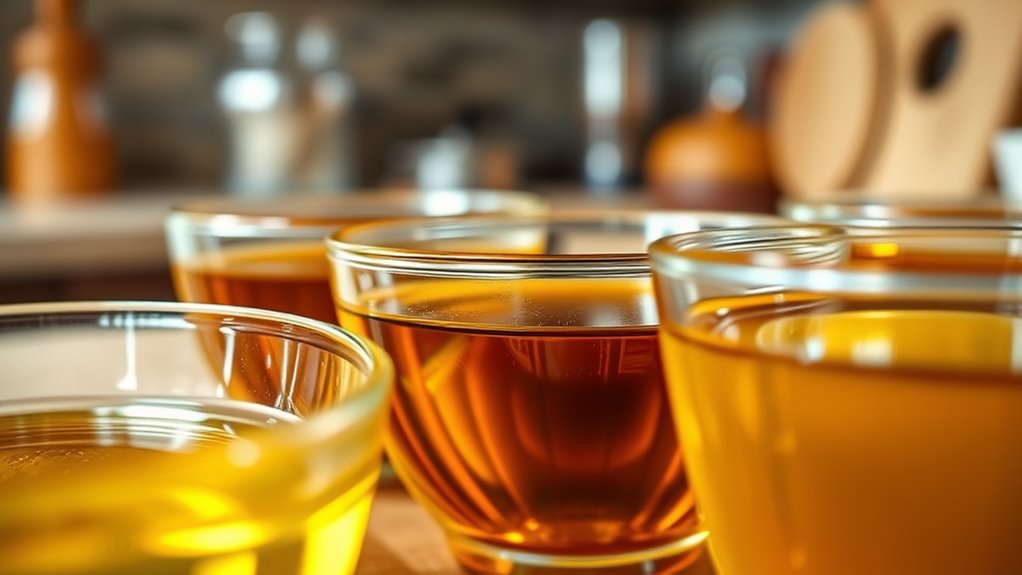
Minor components, though they make up a small percentage of cooking oils, particularly influence their performance and stability during frying. These include tocopherols, phytosterols, phospholipids, γ-oryzanol, lignans, phenolics, and carotenoids, each playing specific roles. Tocopherols act as antioxidants, preventing free-radical chain reactions, but can become pro-oxidant at high concentrations. Phytosterols and γ-oryzanol help inhibit peroxide formation, boosting shelf life. Phospholipids influence smoke points and can accelerate oil darkening, while carotenoids contribute to flavor and color but may turn pro-oxidant at high heat. Lignans generate unique aromas during frying. Their concentrations and interactions vary based on plant origin and processing, making them critical to oil stability, flavor, and health benefits. Understanding these components is essential for optimizing oil selection and frying performance. Additionally, processing methods can significantly alter the levels and effectiveness of these minor components, further impacting the oil’s overall quality. For example, refining processes can reduce beneficial antioxidants, affecting the oil’s resistance to oxidation during high-temperature cooking. Moreover, the presence of antioxidants in oils can be affected by processing, influencing their resistance to oxidation during high-temperature cooking.
Chemical Reactions: Saponification and Hydrogenation
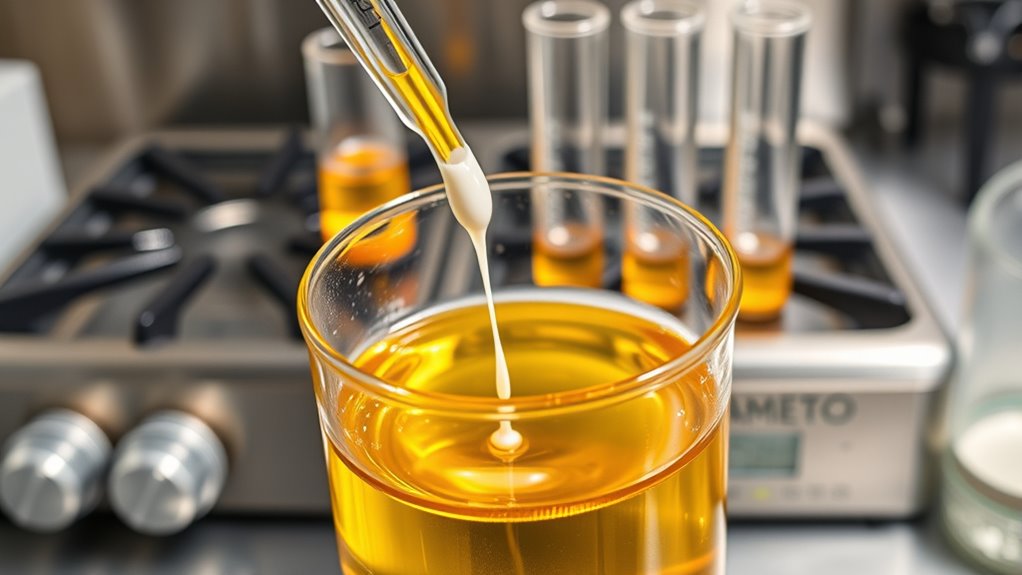
Have you ever wondered how fats transform during cooking and processing? Saponification is a key chemical reaction where triglycerides react with a strong base like NaOH or KOH, breaking down into soap and glycerol. The hydroxide ions attack ester bonds, releasing fatty acid salts with hydrophilic heads and hydrophobic tails, ideal for cleansing. Heat speeds up this process but isn’t essential. Hydrogenation, on the other hand, adds hydrogen to unsaturated fatty acids with metal catalysts like nickel, converting liquid oils into semi-solid fats such as margarine. This reaction saturates double bonds, improving shelf stability. While hydrogenation produces healthier fats, partial hydrogenation can create trans fats linked to health risks. Both reactions are crucial in transforming raw oils into useful, stable products for cooking, cleaning, and food manufacturing.
Oxidation and Rancidity Processes
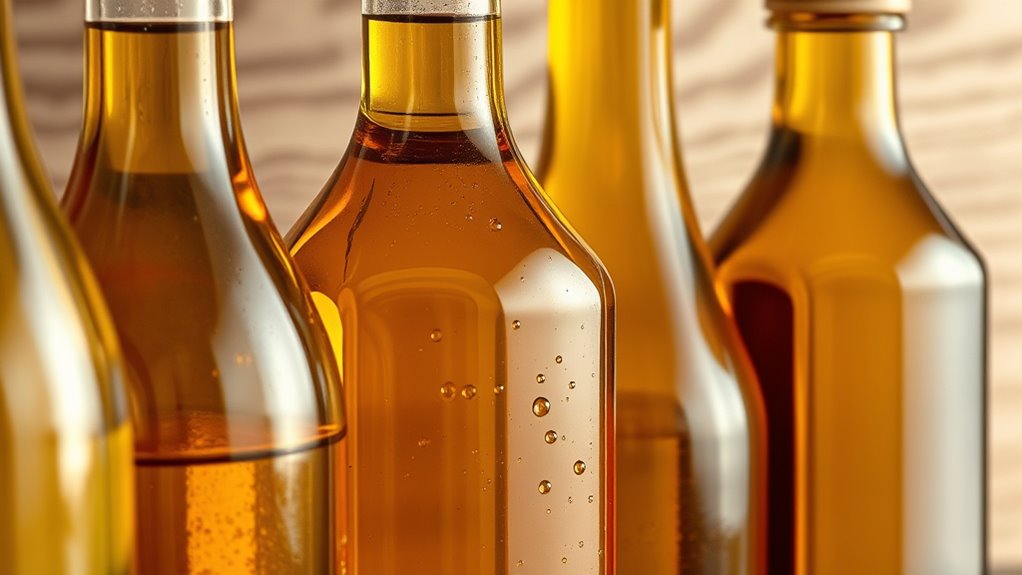
Ever wonder what causes oils to spoil and develop that unpleasant smell or flavor? It’s due to oxidation, a process where free radicals form and react with oxygen. Heat or light exposure starts this by creating radicals on fatty acid chains, especially at double bonds in unsaturated fats. As radicals react, they form peroxyl radicals, leading to chain reactions that produce hydroperoxides and secondary oxidation products like aldehydes. These compounds cause rancidity, giving oils a sour or stale smell and altering their color and texture. High temperatures, oxygen exposure, metal ions, and moisture accelerate oxidation. Over time, oxidative products degrade nutrients and produce potentially toxic compounds. Detecting oxidation involves measuring peroxide levels, conjugated dienes, or aldehyde content, helping you identify when oils are no longer fresh. Understanding oxidative processes can help in developing strategies to prevent or slow down oil spoilage. Additionally, storing oils in cool, dark places can significantly reduce the rate of oxidation, preserving freshness longer. Proper storage also prevents exposure to light and oxygen, further slowing the oxidation process. Maintaining a low temperature and limiting exposure to air are critical factors in preserving oil quality, and a controlled environment can extend shelf life.
Antioxidants and Their Function in Oil Preservation
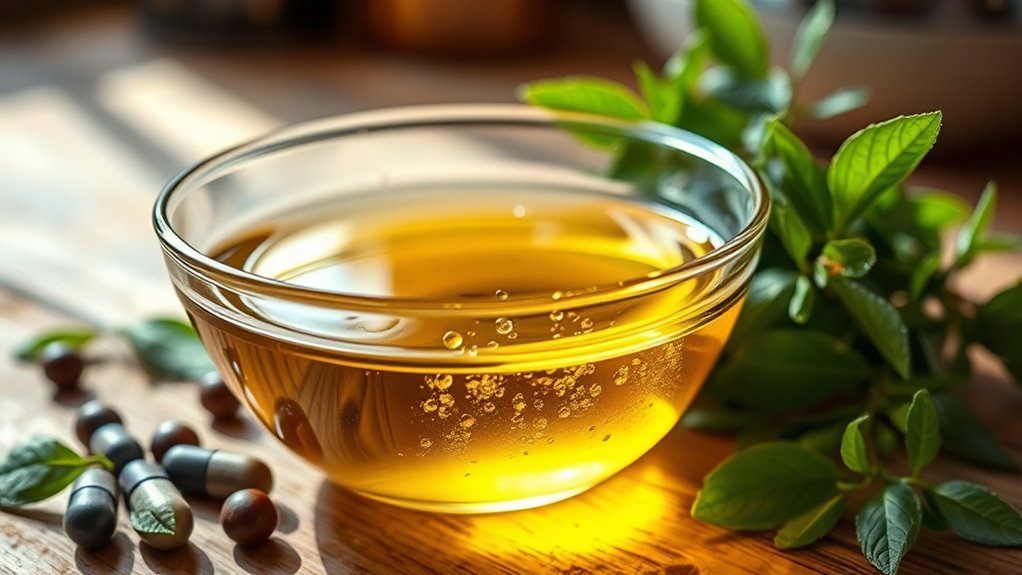
Did you know that antioxidants play an essential role in keeping cooking oils fresh and stable? They work by donating hydrogen atoms to free radicals formed during oxidation, preventing the chain reactions that cause spoilage. Natural antioxidants like tocopherols (Vitamin E) are abundant in vegetable oils, with different forms offering varied stability—sunflower oil is rich in α-tocopherol, while rapeseed contains more γ and δ forms, which are more stable. These antioxidants help oils resist degradation during processing and storage, extending shelf life and maintaining quality. They also protect oils during high-heat cooking, such as frying, by staying active under heat. Antioxidant properties in food preservation and safety are increasingly being explored to enhance the effectiveness of natural antioxidants. Natural sources like olive, green tea, and sesame provide additional antioxidants, which contribute to both preservation and nutritional benefits.
Industrial Applications and Food Preparation
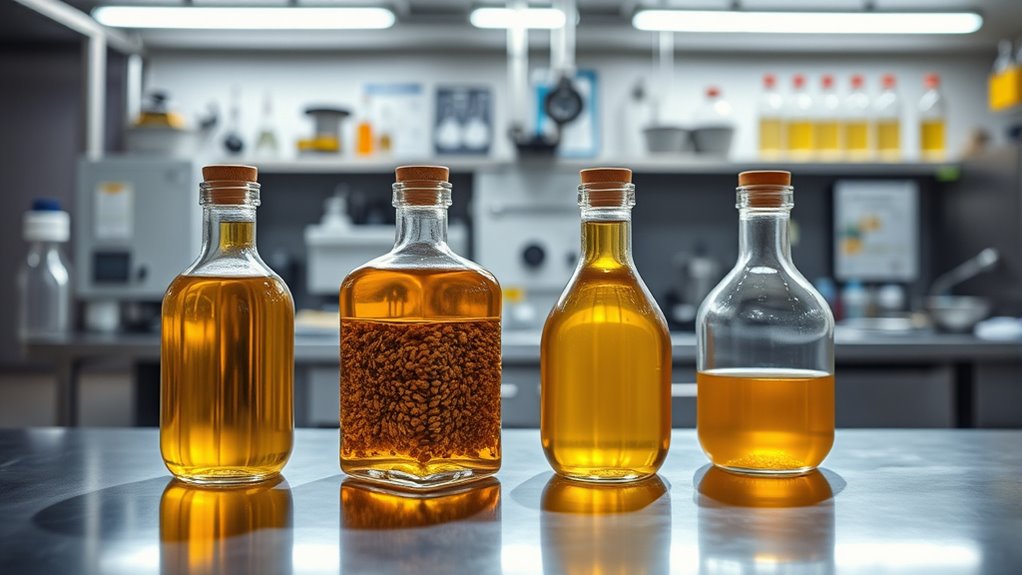
In industrial food preparation, selecting the right cooking oil is essential to guarantee peak performance and product quality. You need to match the oil’s smoke point, flavor profile, and stability to your specific product requirements. Monitoring degradation factors like hydrolysis, oxidation, and polymerization helps extend oil life and maintain safety. The design of your frying system impacts oil turnover and heating uniformity, reducing waste. Continuous filtration removes particulates, slowing down breakdown processes. Proper operator training on moisture control, temperature monitoring, and contamination prevention minimizes premature oil degradation. When optimized, these practices ensure consistent frying quality, enhance flavor, and maximize the efficiency of your production line. Ultimately, choosing and managing the right oil directly influences product consistency and operational costs.
How Temperature Affects Oil Chemistry
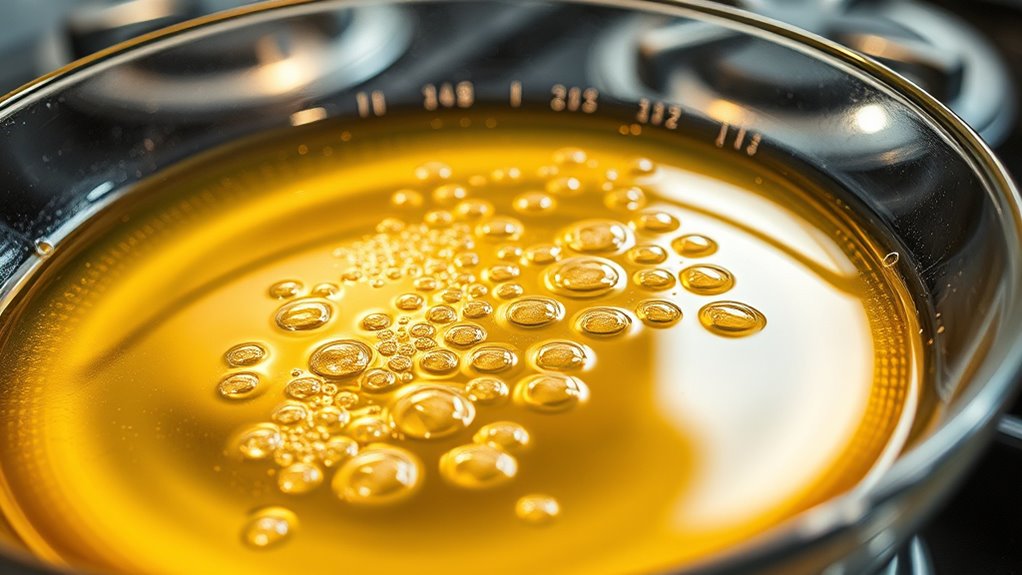
Temperature plays a crucial role in determining how oils behave during cooking. When heated, oils reach their smoke point, releasing toxic compounds like acrolein and off-flavors. At temperatures above 180°C, volatile organic compounds form rapidly, increasing health risks and odor issues. Elevated heat accelerates oxidation, breaking down unsaturated fats into flavor-altering volatiles and depleting antioxidants such as polyphenols and tocopherols. The chemical structure of fats changes through oxidation and oligomerization, affecting oil stability and safety. Heating oils at high temperatures also produces harmful byproducts like aldehydes and polymerized compounds, which pose health hazards and indoor pollution risks. Oils with higher monounsaturated fats, like olive oil, resist degradation longer, but exceeding 200°C often leads to unsafe levels of polar compounds and nutrient loss.
Frequently Asked Questions
How Does Refining Alter the Chemical Composition of Cooking Oils?
Refining changes the chemical makeup of cooking oils by removing impurities, free fatty acids, pigments, and metals through processes like neutralization, bleaching, and deodorization. You’ll notice a reduction in certain vitamins, antioxidants, and polyunsaturated fats because of heat and chemical reactions. These changes improve purity, safety, and shelf life, but they can also lower nutrient levels and alter the oil’s natural flavor and aroma, making it more suitable for cooking and industrial uses.
What Factors Influence the Shelf Life of Different Cooking Oils?
Think of your cooking oil like a delicate flower—its lifespan depends on several factors. You influence its longevity through storage, keeping it in a cool, dark place, and sealing it tightly. Exposure to light, heat, and air speeds up spoilage. Using airtight containers and avoiding refrigeration can help, but ultimately, the oil’s fatty acid composition determines how long it stays fresh before turning rancid.
Can Cooking Oils Be Genetically Modified for Better Health Benefits?
You might wonder if cooking oils can be genetically modified for better health. Yes, GM oils like canola are engineered for pest resistance and higher yields, with some aiming to optimize fatty acids for heart health. While current research shows they’re safe and may offer benefits like improved insulin sensitivity, long-term effects aren’t fully known. You can choose organic or non-GMO options if you prefer avoiding genetic modifications.
How Do Frying Temperatures Impact Oil Stability and Nutritional Value?
Frying temperatures are like a double-edged sword—too hot, and you’re racing against time, speeding up oil breakdown and losing nutritional treasures. When you crank up the heat above 400°F, the oil’s stability crumbles, releasing harmful compounds and degrading antioxidants. Keep it within the ideal range of 350-375°F, and you preserve both flavor and nutrition, ensuring your food stays delicious without sacrificing health.
What Role Do Antioxidants Play in Preventing Oil Oxidation During Storage?
You want to know how antioxidants prevent oil oxidation during storage. They donate hydrogen to free radicals, stopping harmful chain reactions that cause spoilage. Natural antioxidants like rosemary extract are especially effective, even at high temperatures, thanks to their stability. By adding these, you extend your oil’s shelf-life, maintain quality, and reduce harmful compounds. Plus, natural options are preferred for health reasons, making your stored oils safer and more nutritious.
Conclusion
Understanding the chemistry behind cooking oils reveals how their composition impacts flavor, stability, and health. While some believe all oils are interchangeable, the truth is that their unique chemical makeup determines their suitability for different cooking methods. By examining factors like fatty acid structure and oxidation, you can make smarter choices. Remember, oils rich in antioxidants and with proper saturation levels resist rancidity longer, proving that chemistry truly influences your kitchen’s success.
